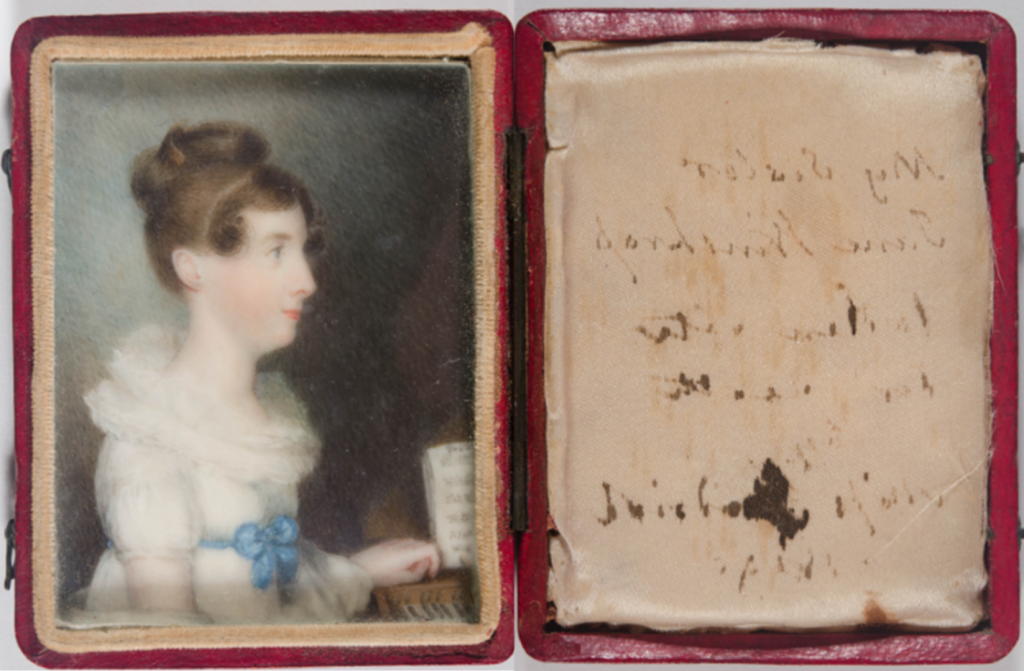by Isabella Dobson, PhD Student at Boston University in History of Art and Architecture
查看 miniature mourning portrait of Jane 温斯洛普 is just as much a tactile experience as a visual one. Undoing the tiny clasps and folding open the case reveals an interior lined with satin and velvet and offers a tangible, intimate encounter with the deceased. Jane’s bright coral lips and rosy cheeks suggest youth and alertness, and her only visible blue eye gazes hopefully beyond the frame. 然而, the satin lining opposite Jane’s portrait adds a bittersweet undertone; a few faded lines of text hand-inked by Jane’s younger brother Robert C. 温斯洛普 read, “My sister/Jane 温斯洛普/taken after/her death/by/Sarah 古德里奇/1819”. 生于1801年, Jane would have only been seventeen when she passed away, making 古德里奇’s vivid posthumous likeness particularly heart-wrenching.[1]

在一个没有摄影的时代, miniature mourning portraits like this one served as precious reminders of deceased loved ones’ image and presence. A greater emphasis on romantic and familial bonds beginning in the late 18th 世纪使损失更加难以承受.[2] 事实上, 她死后的第二天, Jane’s father Thomas Lindall 温斯洛普 writes to his sister to share news of his daughter’s death, mourning “the dissolution of one of the most innocent, purest-minded, and loveliest girls that perhaps ever existed.”[3] 温斯洛普’s praise of Jane’s virtues conveys his love for her and reveals the grief he feels in her absence. Jane’s portrait mirrors this verbal praise; her white dress and its collar of soft, layered frills suggest the purity and grace her father lauds and whose loss finds the whole family “in great affliction”.[3] In contrast to her youthful countenance, Jane’s hairstyle suggests that she has entered womanhood since her curled bangs and pinned-up bun match the style worn by the thirty-year-old Caroline Hall Parkman in her own 微型画像.[4]

虽然罗伯特, 这幅画像的铭文, was only nine when his sister passed, his later writings bring Jane’s portrait to life. The piano on which Jane rests her hand assumes special significance when considered alongside a memory recounted by Robert in a letter from 1877. Recalling how his “six or seven brothers and sisters used to gather around the piano”, Robert writes that this memory “brings back a family group—of which I am the youngest and now the only survivor—as vividly as I hope one day see it above”.[5] Surely viewing his sister’s portrait, 带着它的微型钢琴, would have reminded Robert both of these fond memories and the painful losses that eventually followed.
Crammed into the corner, the piano—where Jane could often be found in life—also echoes the early 19th-century idea that the process of mourning fulfilled “a fundamental need to imaginatively or tangibly locate the dead in a specific way.”[2] 在给他妹妹的信中, Thomas 温斯洛普 writes that he believes Jane to be “happy in another and better world”, marking his desire to cognitively pinpoint his deceased daughter.[3] 古德里奇, 太, positions Jane between this world and the next; even as Jane appears alive and alert, her gaze drifts beyond the piano, symbolically disconnecting her from earthly pastimes like playing music. Though Jane is unreachable in death, her presence remains accessible to her loved ones through 古德里奇’s portable, 亲密的照片.
[1] 肖梅奥, 美国的温斯洛普家族, 218. Jane was born on March 15, 1801, and died February 22, 1819, in Boston.
[2] 贾菲弗兰克, Love and Loss: American Portrait and Mourning Miniatures, 7.
[3] 温斯洛普, Thomas Lindall, Letter to sister Jane Stuart, February 23, 1819. It must have been a sort of cruel irony to write to one Jane that another Jane had died.
[4] 马萨诸塞州历史学会 Online Collections page for portrait miniature of Caroline Hall Parkman. The sitter was born in 1794 and the portrait was made ca. 1824.
[5] 温斯洛普小.——罗伯特·C., 罗伯特·C的回忆录. 温斯洛普, 297. Robert had 14 siblings, so to be the lone survivor is a particularly lonely position to occupy.

